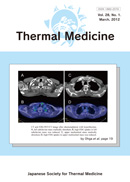All issues

Volume 28 (2012)
- Issue 4 Pages 53-
- Issue 3 Pages 43-
- Issue 2 Pages 23-
- Issue 1 Pages 1-
Volume 28, Issue 1
Displaying 1-3 of 3 articles from this issue
- |<
- <
- 1
- >
- >|
Reviews
-
From NK Cell-based Science to Clinical ApplicationHIROSHI TERUNUMA, XUEWEN DENG, ATSUSHI TOKI, AKIKO YOSHIMURA, NORIYUKI ...2012 Volume 28 Issue 1 Pages 1-9
Published: March 20, 2012
Released on J-STAGE: May 21, 2012
JOURNAL FREE ACCESSHyperthermia has been known to enhance the host immune responses against cancer through several mechanisms. One of the mechanisms is sensitization of cancer cells to natural killer (NK) cells through enhancement of NK cell-activating ligands on cancer cells. However, NK cell number and cytotoxicity in patients with cancer is often low. Therefore, NK cell-based adoptive immune cell therapy can be applied for cancer patients after hyperthermia. In this paper, we discuss these findings from our data. Moreover, we present the clinical usefulness of combining hyperthermia, immune cell therapy, and low-dose chemotherapy as palliative treatment for advanced stages of cancer, which are refractory to conventional therapy in the context of NK cell-mediated immune responses.View full abstractDownload PDF (243K) -
Clinical and Experimental AnalysesTSUTOMU TAKEDA, TOHRU TAKAHASHI, ITSUO YAMAMOTO, TAKEO HASEGAWA, TAKAS ...2012 Volume 28 Issue 1 Pages 11-16
Published: March 20, 2012
Released on J-STAGE: May 21, 2012
JOURNAL FREE ACCESSA symposium entitled "Immunological Science of Hyperthermia (basic and clinical)" was held during the 28th annual meeting of the Japanese Society of Thermal Medicine in September, 2011. We presented the following clinical and experimental data in this symposium.
Clinical : We treated 1,386 patients with advanced or recurrent cancer by hyperthermia, immunotherapy or their combination, between July 2005 and August 2011. Hyperthermia was applied in 1,307 patients, activated lymphocytes therapy (CAT) in 995 patients, and dendritic cell therapy (DC) in 689 patients. The response to therapy was evaluated retrospectively in 1,343 patients, and 188 (14.0%) responded to therapy, including 35 who showed a complete response. The response to immunotherapy increased from 8.1% to 17.9% when it was combined with hyperthermia, and the response was the highest in patients who received the combination of CAT+DC+hyperthermia.
Experimental : Mice inoculated with Lewis lung cancer (LLC) tumors were treated with hyperthermia or CAT. Each of hyperthermia and CAT reduced tumor growth and rate of lung metastasis, and the effects were more pronounced in animals treated by the two modalities. Each of hyperthermia and molecular target therapy reduced tumor growth and rate of lung metastasis, and increased the proportion of apoptotic cells in the tumor, and the effects were more pronounced in animals treated by the two modalities. The results suggest that hyperthermia enhances the effects of immunotherapy in cancer patients.View full abstractDownload PDF (344K)
Case Report
-
SAIJI OHGA, KATSUMASA NAKAMURA, TADAMASA YOSHITAKE, YOSHIYUKI SHIOYAMA ...2012 Volume 28 Issue 1 Pages 17-22
Published: March 20, 2012
Released on J-STAGE: May 21, 2012
JOURNAL FREE ACCESSHyperthermia is a less invasive treatment than chemotherapy, radiotherapy and surgery. However, there has been no report about the safety of administering repeated hyperthermia treatments over a long period. This report describes a patient who received 86 hyperthermia treatments over the course of four years.
A 65-year-old man was diagnosed with advanced esophageal cancer in the middle portion of the thoracic esophagus. He underwent a subtotal esophagectomy with gastric tube reconstruction. Five months after surgery, recurrent lesions were revealed on a computed tomography (CT) examination in the upper mediastinum and left supraclavicular region. Chemoradiation with a total dose of 60 Gy was performed in combination with hyperthermia as an initial treatment for these recurrences. Concurrent chemotherapy consisted of cisplatin (CDDP) and 5-fluorouracil (5FU). Hyperthermia was applied with an RF-capacitive heating apparatus (Thermotron RF-8, Yamamoto Vinita, Osaka, Japan) for 50 minutes twice a week. On a CT examination at the end of two months, both of the recurrent masses had decreased in size. Therefore, chemotherapy using CDDP and tegafur-uracil (TS-1), combined with twice-weekly hyperthermia, was performed as an adjuvant therapy for two weeks. Subsequently, he continued to receive hyperthermia once a week or once every three weeks for 3.5 years. At present he has had no adverse effects associated with the hyperthermia and no recurrence.View full abstractDownload PDF (1770K)
- |<
- <
- 1
- >
- >|